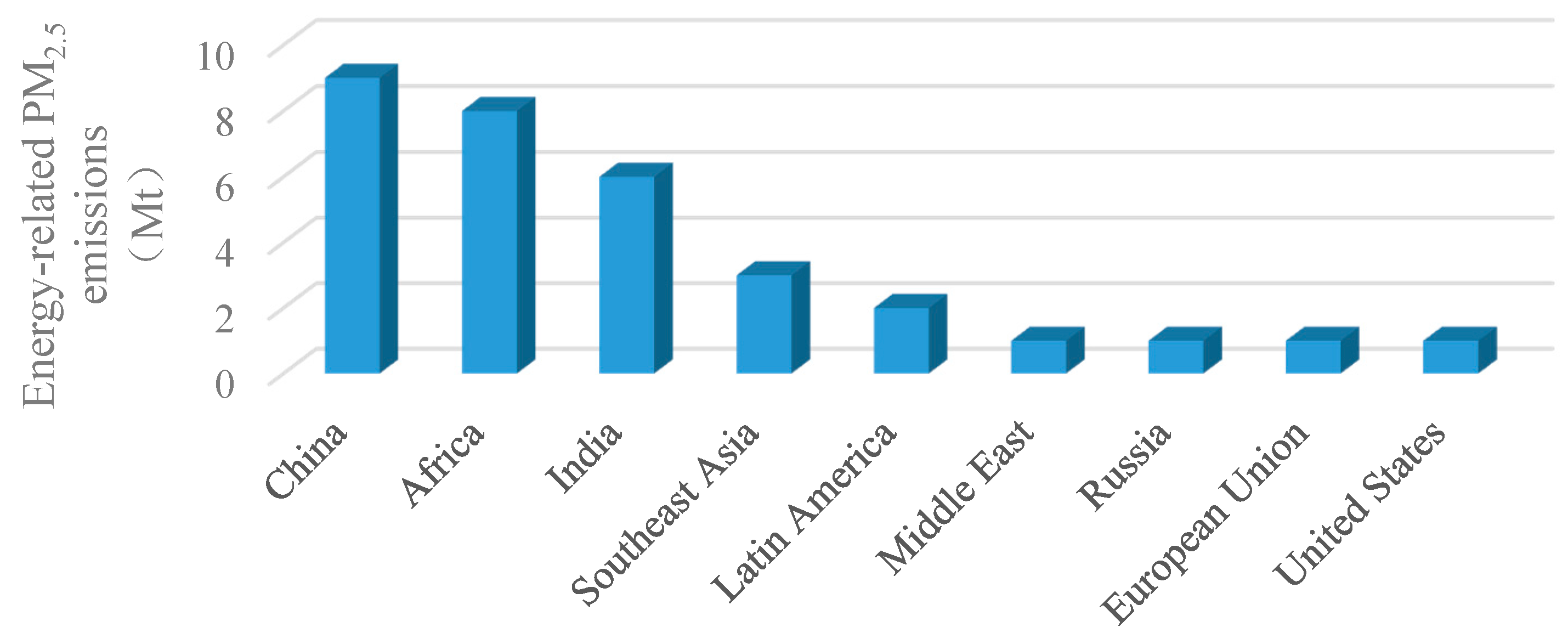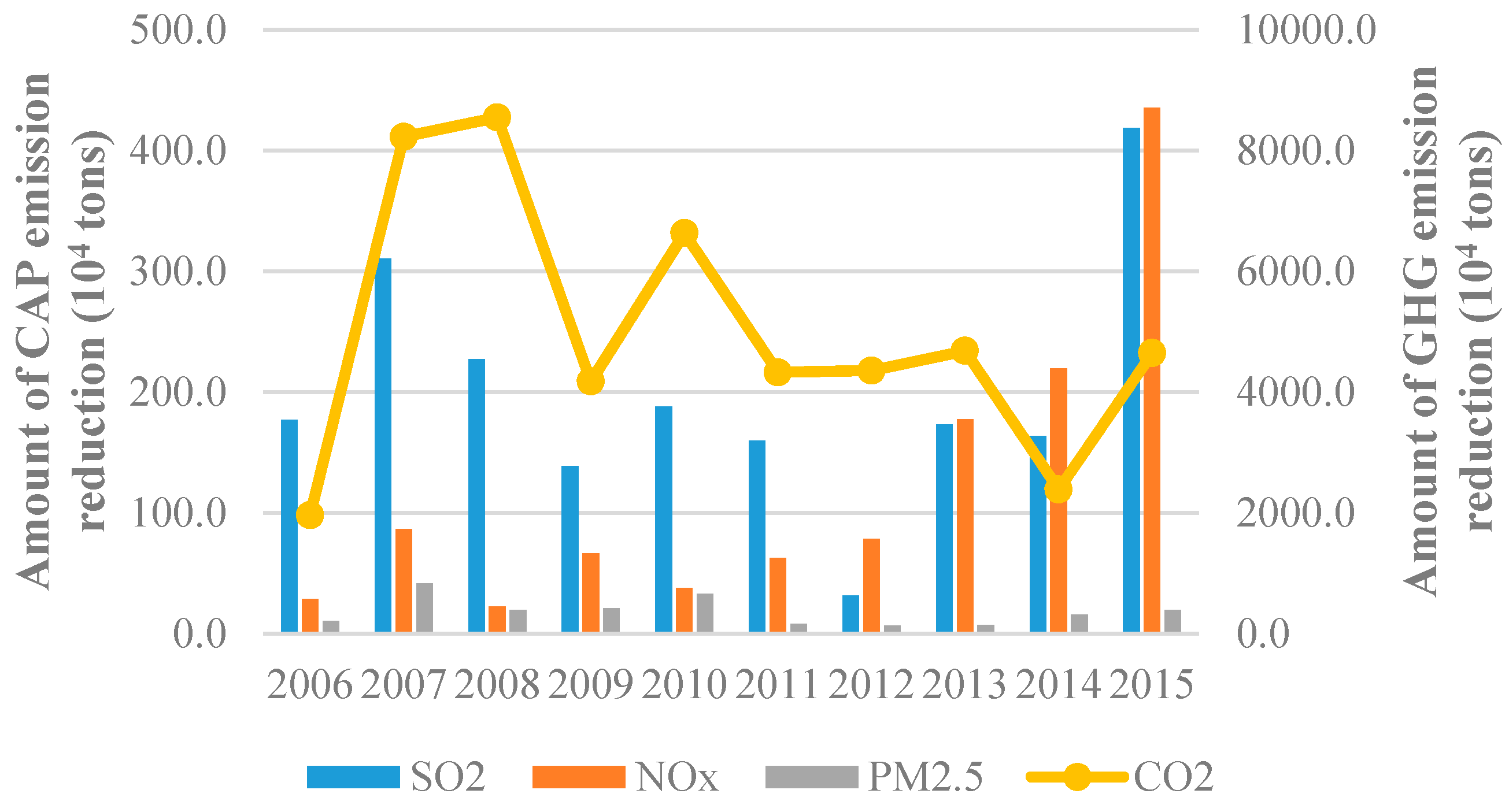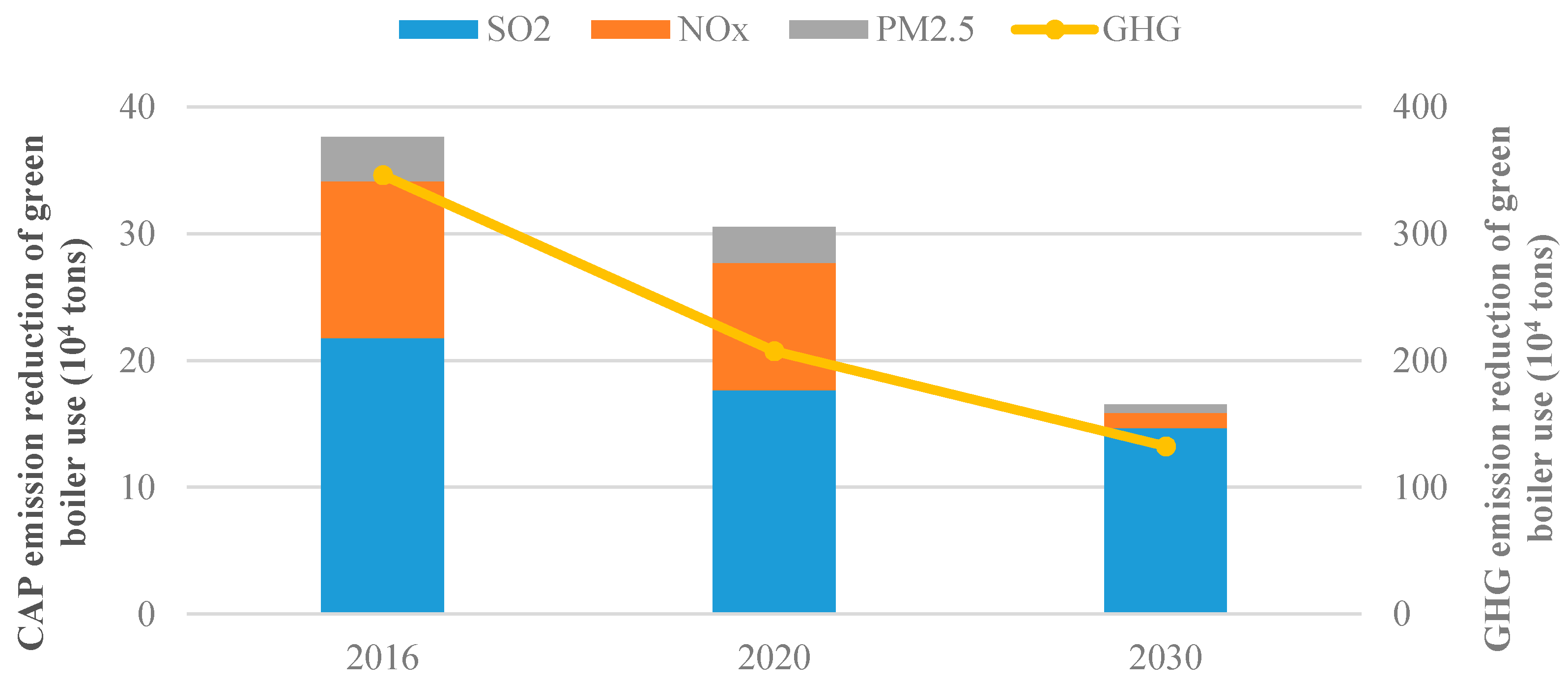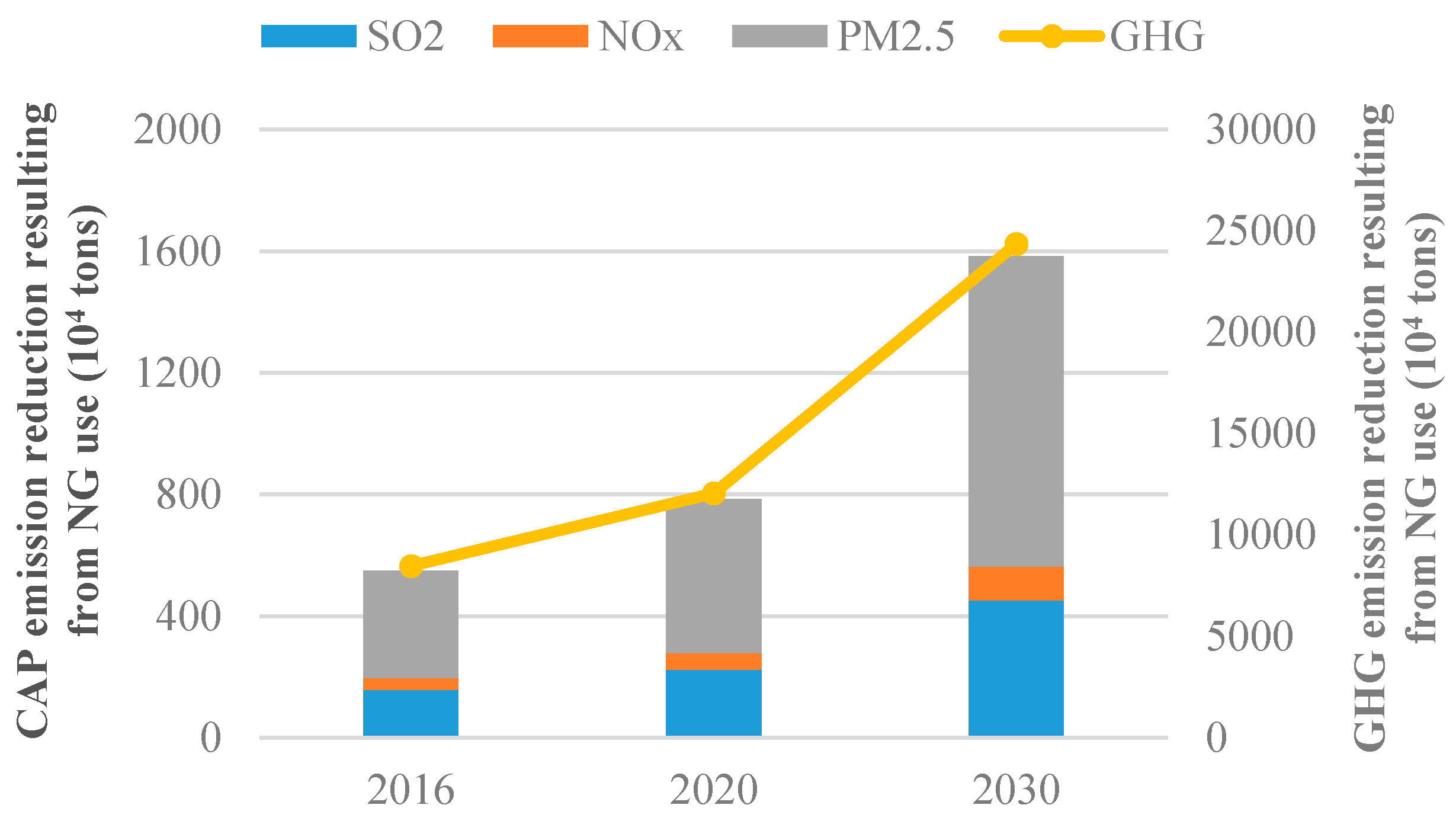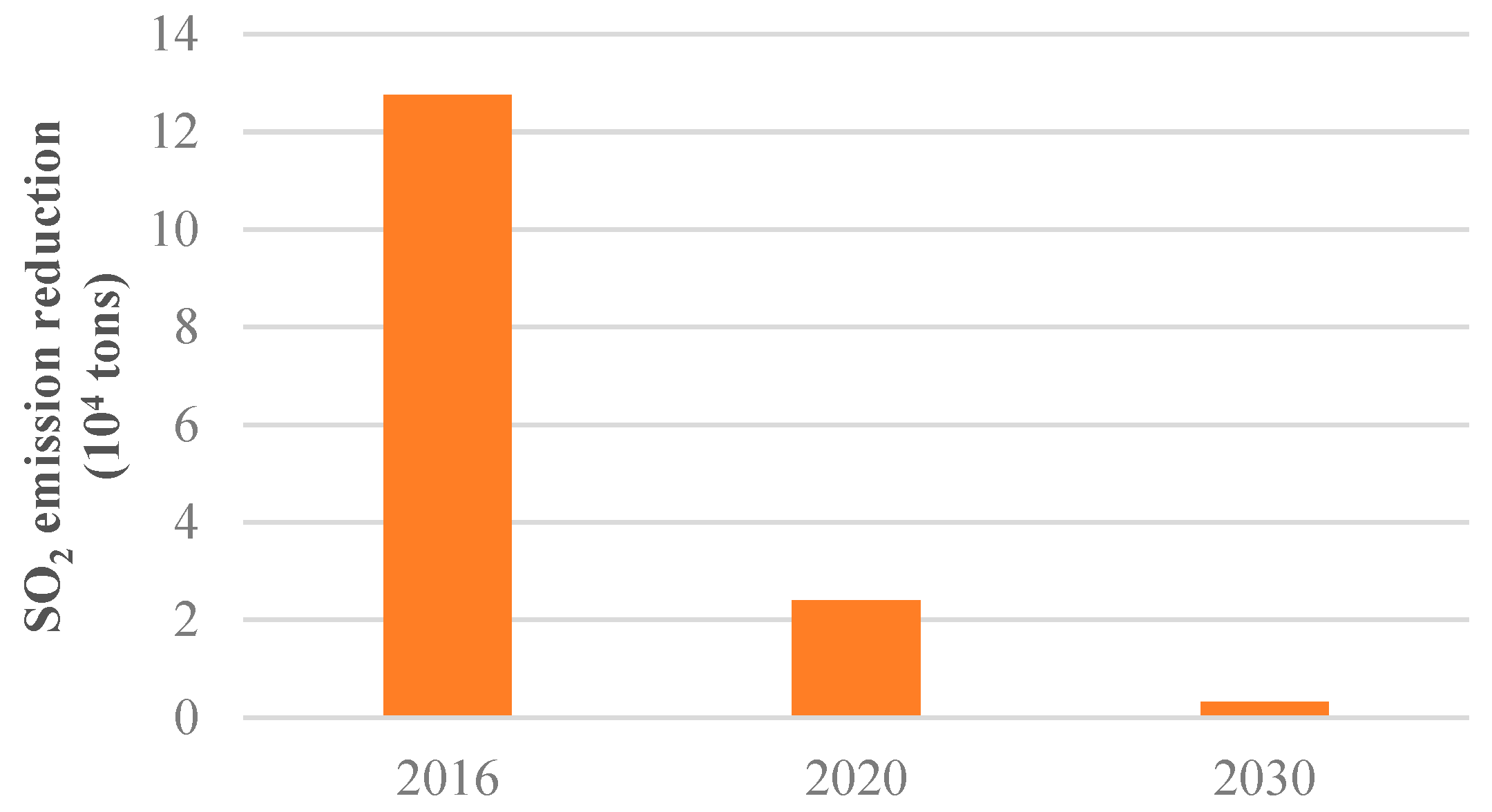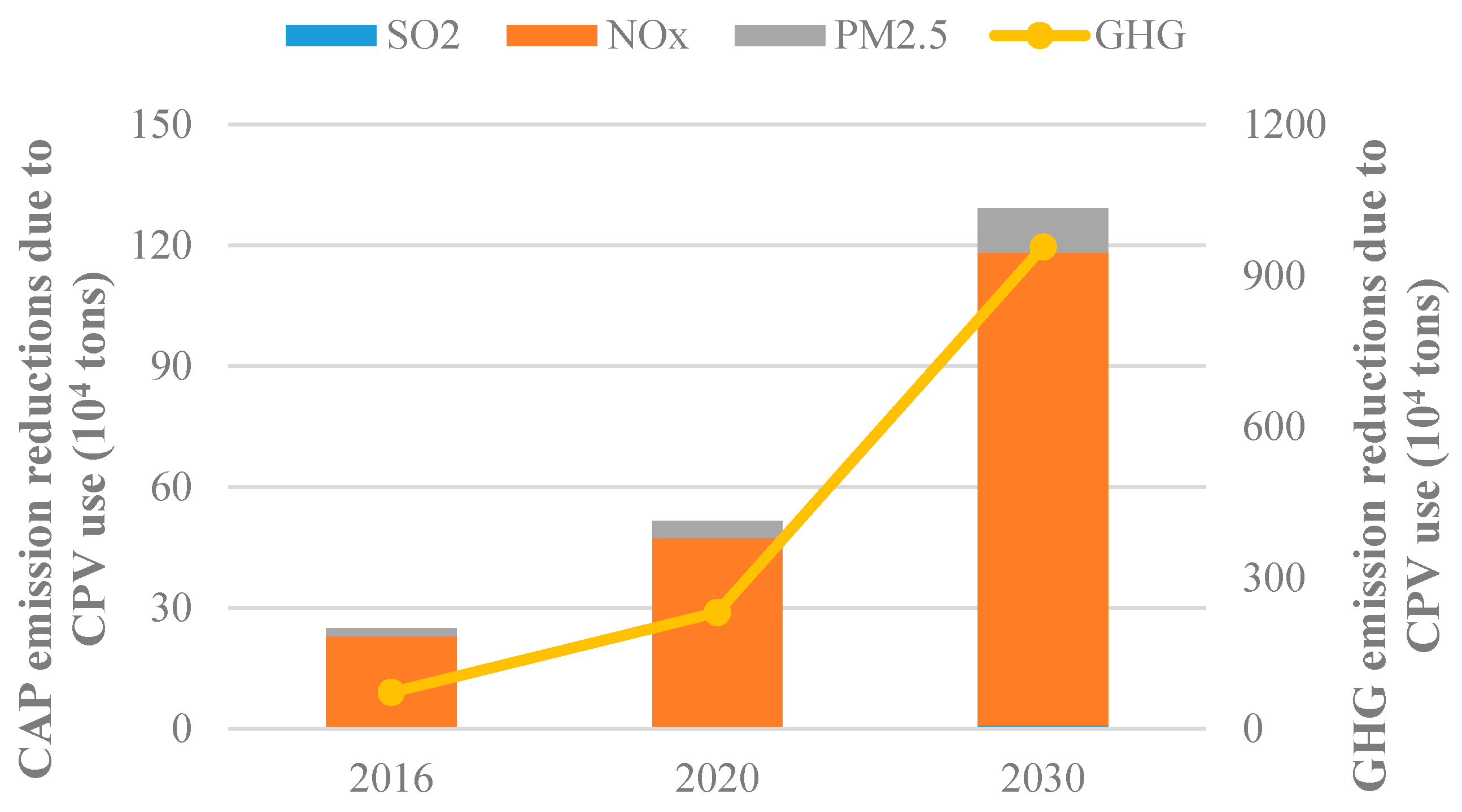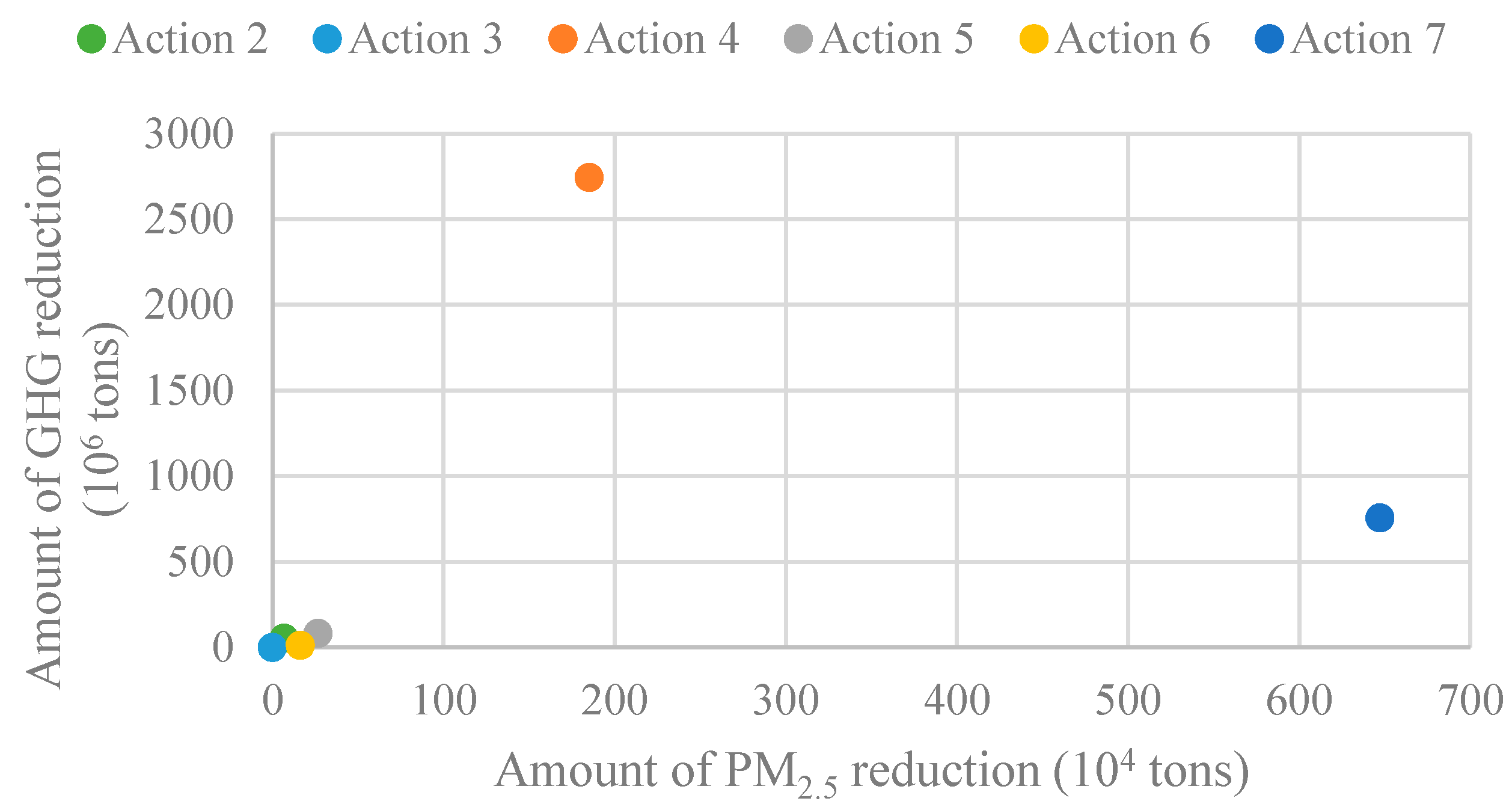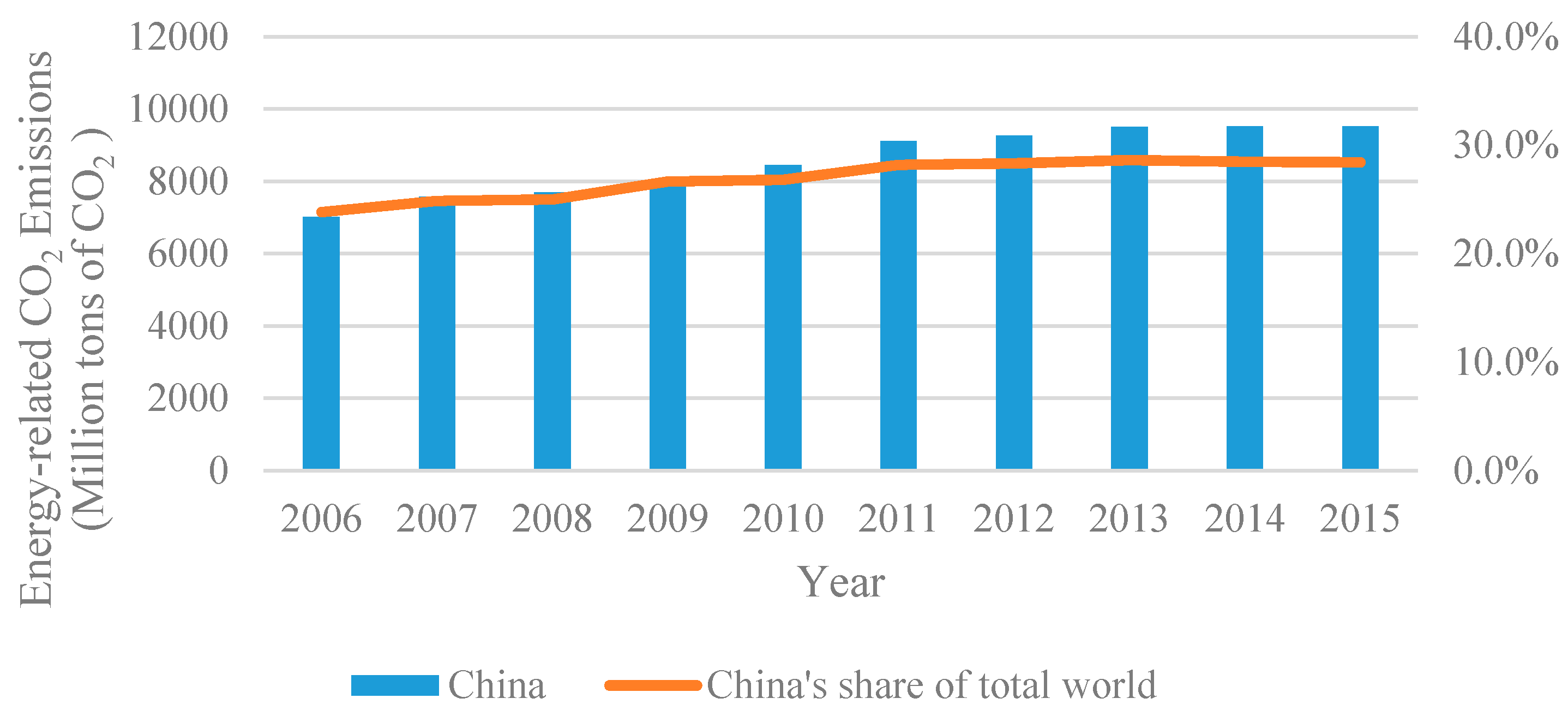1. Introduction
As the population of the world increases and the economy of the world prospers, and especially as developing countries advance, energy needs have increased significantly. Between 1971 and 2015, the global total primary energy consumption increased significantly by a factor of almost 2.6 [
1,
2]. The share of high-carbon fossil energy sources, such as coal and oil, is gradually decreasing, while other relatively low-carbon energy sources grow rapidly, but the former still dominates the world total primary energy consumption, accounting for more than 60% [
2,
3,
4]. Due to the heavy utilization of fossil energy, high-carbon energy structures and the number of ways in which energy is used, enormous quantities of greenhouse gas (GHG) and critical air pollutants (CAPs) have been released. Energy-related GHG emissions accounted for the largest share of global anthropogenic GHG emissions, approximately 68%, and directly contribute to climate change [
4,
5]. Although coal represented approximately 29.2% of the world total primary energy consumption in 2015, coal accounted for approximately 46% of the global CO
2 emissions, representing the largest share of GHG emissions due to its heavy carbon content per unit of energy released [
5,
6,
7]. Energy utilization is an important source of large quantities of directly emitted hazardous air pollutants such as particulate matter (PM, PM
2.5 specifically) and sulfur dioxide (SO
2), and energy use was responsible for approximately 85% and almost 99% of the of global emissions of each of these pollutants, respectively, in 2015 [
7,
8].
As large quantities of GHG, predominantly CO
2, and CAPs have been released, increasingly serious climate change and air pollution (haze pollution especially) problems have arisen. For the past few decades, changes in climate have caused various impacts on natural and human systems on almost all continents and across the oceans [
4,
9,
10,
11]. Climate change is disrupting national economies and affecting lives, costing people, communities and countries dearly today and even more tomorrow. Simultaneously, in recent decades, air pollution has produced significantly adverse impacts on human health and the environment (as listed in
Appendix A Table A1) [
7,
8,
9,
12]. In particular, many areas have suffered from serious haze disasters, such as the Donora smog event of 1948, the Great Smog of London in 1952, and the severe haze event in Beijing in 2013. These events greatly affect daily life, human health and can even cause many deaths [
13,
14,
15].
Due to the increasing appeal of a high standard of living and the urgent duty of countries to pursue the sustainable development of the economy, society, and environment, actively addressing climate change and air pollution are necessary actions [
9,
16,
17,
18]. Given that climate change and air pollution have the same source, methods to address these problems should focus on the rational development and utilization of energy for collaborative governance, which can generate environmental benefits [
19,
20,
21]. As the world actively works to address the risks of climate change and air pollution, there is growing concern about initiating rational energy countermeasures that achieve environmental objectives without undermining the growth of the global economy and the aspiration for a better quality of life for all. Numerous studies have been conducted to analyze the links between energy, climate change and air pollution and to assess the synergies between addressing climate change and air pollution [
22,
23,
24]. Apsimon et al. [
22] examines the interactions between strategies designed to improve air quality and those addressing climate change, analyses the benefits of combined strategies with greater attention to the overall environmental impacts, and focuses on finding “win–win” solutions for Europe. Another study conducted by Zeng et al. [
23] aimed to design a co-control plan using a linear programming method for local air pollutants and CO
2 reduction. The case study in Urumqi, a city in China, showed that technical reduction measures, such as energy recycling, as well as energy efficiency improvements and resource recycling measures have been shown to be control options that contribute to both reductions in local air pollutants and CO
2. As demonstrated by Maione et al. [
24], coordinated actions that take into account air quality-climate linkages examined from a policy perspective are required based on the Integrated Assessment Modeling (IAM) model to achieve win–win scenarios. Most previous studies have investigated the co-benefits, including environmental benefits and health benefits, of addressing climate change and air pollution in parallel using simulation models, such as the long-range energy alternatives planning (LEAP) model and the Asia-Pacific Integrated Model (AIM/Enduse) model based on scenario settings. He et al. [
25] adopted an energy projection model, an emission estimation model, an air quality simulation model and a health benefit evaluation model for assessing the co-benefits achieved under different energy policies in China by 2030. In another study, Xie et al. [
26] evaluated the synergies of climate change and air pollution in parallel using a LEAP model based on scenario simulations of energy consumption in Beijing. To analyze the potential and cost to reduce air pollutants while achieving the 2 °C global temperature change target relative to pre-industrial levels, Hanaoka et al. [
27] used a bottom-up optimization model, AIM/Enduse (Global), based on emission constraint scenarios and carbon tax scenarios. From an international perspective, there is a gap in the knowledge regarding establishing a simple and practical analytical framework focusing on quantitatively evaluating the effect of specific energy countermeasures aimed at tackling climate change and air pollution based on the characteristics of the existing energy structure. The current study places emphasis on establishing a multi-dimensional, multi-perspective and achievable framework for the quantitative evaluation of energy countermeasures that intend to achieve the reduction of GHG and CAPs emissions for the sustainable development of the world, especially for developing countries facing these challenges.
The goal of this study was to provide an aid in planning energy-related countermeasures aimed at developing a coordinated response to climate change and air pollution while guaranteeing the sustainable development of the economy and society. This article is structured as follows.
Section 2 presents a background on energy consumption, and GHG and CAP emissions in China.
Section 3 proposes a detailed analytical framework for evaluating the effects of energy countermeasures on simultaneously tackling climate change and air pollution. In
Section 4, the proposed analytical framework is used to evaluate a typical case study.
Section 5 presents lessons for countries similar to China. The paper ends with concluding remarks for decision-making.
5. Lessons for Countries Similar to China
Given the increasing attention to the significant impacts of climate change and air pollution, society is increasingly emphasizing finding ways to provide more clean energy for a growing global population while emitting much less GHG and CAPs. The Paris Agreement reached in the 21st Conference of the Parties held in Paris in December 2015 is a major milestone in the effort to combat climate change and will also play a vital role in reducing air pollutants. The ultimate objective, which has already been adopted by the governments of more than 150 countries, is to limit global warming to an average of no more than 2 °C relative to pre-industrial levels [
4,
18,
33]. To achieve the 2 °C target, global anthropogenic GHG emissions must be decreased by 40–70% by 2050 compared to 2010 levels, and emissions levels must be near zero or below zero by 2100 [
4]. Many countries, including China, have submitted their Intended Nationally Determined Contributions (INDCs), mainly focusing on achieving peak CO
2 emissions, lowering CO
2 emissions per unit of GDP, and increasing the share of non-fossil fuels in primary energy consumption. Facing these huge challenges, many countries must take suitable countermeasures, especially from an energy perspective, to guarantee green and low-carbon development.
5.1. Establishing an Analysis Framework
As stated above, the energy countermeasures aimed at addressing climate change and improving air quality implemented in China can play a significant role in reducing CAP and GHG emissions. This finding also means that the analysis framework presented here is helpful for China to identify energy action options and to investigate the order in which the plans should be implemented and prioritized. Many countries similar to China also need to establish an analysis framework based on the characteristics of their domestic energy consumption and GHG and CAP emissions. Based on the analysis framework established here, these countries can make wise decisions on the implementation of suitable energy actions to tackle climate change and air pollution. Additionally, actively promoting the use of energy-saving stoves in rural areas is a way of promoting the clean and efficient use of coal, which is helpful in achieving energy savings and emission reductions. Although the use of such stoves is also an energy action option to reduce CAP and GHG emissions, this action falls outside of the scope of this paper. The analysis framework presented in this paper can serve as a model for countries similar to China.
5.2. Using the Framework to Evaluate the Emission Reduction Effect of Energy Countermeasures
After the analysis framework has been established, the emission reduction effect of energy countermeasures implemented in these countries can be measured using the proposed calculation methods. As with the methods used for China, these calculations could adopt a “with and without” comparison method. A comparison of scenarios with and without the implementation of the given energy actions in a target year allows for the calculation of emission reductions in GHG and CAPs. If the energy countermeasures implemented obtain emission reductions, the comprehensive and collaborative effects of energy actions can be identified. Although this proposed framework is presented for the analysis of the emission reduction effects of energy countermeasures at the country level, the framework can also be used for analyses at the province level or city level if key data can be obtained.
5.3. Identifying Vital Energy Countermeasures with Effect Analysis
The overall emission reduction effect of energy countermeasures implemented can be measured with an analysis of comprehensive effects. This approach will be helpful in identifying the potential to achieve the emission reduction targets of these countries, including China. For example, the Chinese government has made certain energy commitments, such as raising the low-carbon fuel rate to 20% by 2030. These considerations have been taken into account in the case study presented here. The comprehensive effect analysis finds that raising the low-carbon fuel rate can result in significant emission reductions, which is helpful in achieving environmental targets. The energy actions analyzed in this study support the control of CAP and GHG emissions in parallel. Moreover, this analysis can help identify the GHG and CAP emission reduction effect sizes of each energy action, which can help in the investigation of key actions and the identifying implementation priorities. Therefore, action priorities should be identified when energy actions are needed to tackle climate change and to improve air quality. For example, if the work priority is to improve air quality, energy actions contributing to reducing PM2.5 emissions, such as reducing the use of rural charcoal burning, should be prioritized. Similarly, for tackling climate change, energy actions contributing to reducing GHG emissions, such as replacing coal with NG in urban and rural areas, should be prioritized. The effect analysis is also helpful for exploring the order in which energy actions should be taken for different targets to maximize emissions reduction. This effect analysis can identify suitable energy countermeasures while incorporating regional differences. For example, in northern areas, centralized heating is an effective way to reduce GHG and CAP emissions.
5.4. Issuing Assistance Measures to Support the Implementation of Energy Countermeasures
Given the significant emission reduction effect of energy countermeasures, ensuring the implementation of these energy actions is key. Using China as a case study, these countries should take a number of additional measures, such as issuing policies and regulations, to ensure the implementation of these energy countermeasures. When replacing coal with NG in urban and rural areas, for example, measures to support the implementation of this energy action may be necessary, e.g., strengthening the construction of NG infrastructure, adjusting the price of NG to make it competitive, and improving pollutant emission standards to promote the use of NG. If the assistance measures are not powerful enough to ensure the implementation of these actions, the implementation effect of energy actions will be difficult to measure, which will in turn affect the decision-making process on measures to climate change and improve air quality.
6. Concluding Remarks
To tackle climate change and air pollution in the pursuit of sustainable development, many countries, including China, are increasing their efforts to develop and implement suitable energy countermeasures. This paper establishes a framework for the quantitative evaluation of the emission reduction effects of energy actions that provide suitable energy countermeasures. This analysis framework focuses on implementing “upgrading, replacing and centralizing” actions to achieve energy transitions based on the characteristics of energy consumption and related GHG and CAP emissions.
As a typical developing country pursuing green and low-carbon development, China is taken as an example to demonstrate the application of the proposed analysis framework to evaluate the effect of the presented energy actions. Using the proposed framework, the emission reduction effects of energy actions implemented in China are estimated. The results indicate that, due to the implementation of the presented energy actions, a significant emission reduction effect on CAPs and GHG has been achieved. There are differences in the emission reduction effects of each energy action, especially for different targets. This finding means that the proposed framework can not only effectively help China identify the effect of a given energy action on reducing GHG and CAP emissions but can also help China identify key actions and their implementation priority and order to maximize emissions reductions for different targets. This framework can help China generate ideas and develop programs to tackle climate change and haze pollution. Moreover, this proposed framework can also help countries similar to China make decisions on suitable energy countermeasures to address climate change and improve air quality.
Based on the analyses presented in this paper, when developing suitable energy countermeasures to maximize emissions reductions, some key actions should be taken. First, priorities should be identified when energy actions are needed to tackle climate change and to improve air quality. Second, the implementation priority and order of energy actions should be evaluated to maximize emission reductions. Third, suitable energy countermeasures should incorporate regional differences. Finally, measures should to be taken to support and ensure the implementation of these energy actions.

